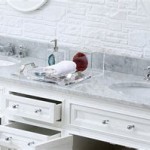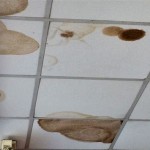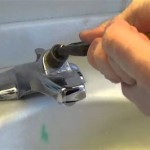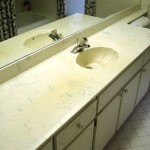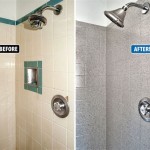How To Replace A Bathroom Vanity Top And Sink Combo
Replacing a bathroom vanity top and sink combo is a home improvement project that can significantly enhance a bathroom's aesthetics and functionality. While it might seem daunting, with careful planning, the right tools, and a systematic approach, most homeowners can successfully complete this task. This article provides a comprehensive guide to replacing a bathroom vanity top and sink combo, ensuring a smooth and efficient process.Before commencing any work, safety is paramount. Shut off the water supply to the bathroom. This is typically done at the shut-off valves located beneath the sink. If those valves are corroded or non-functional, the main water supply to the house should be shut off. Protect the work area by laying down drop cloths or protective sheeting to prevent damage to the flooring and surrounding fixtures. Gather all necessary tools and materials to minimize interruptions during the project.
Essential tools include a wrench (adjustable or basin wrench), a screwdriver (Phillips and flathead), a utility knife, a caulk gun, a level, a tape measure, safety glasses, and work gloves. Materials required, besides the new vanity top and sink combo, encompass plumber's putty, silicone caulk, new supply lines (if needed), and possibly shims for leveling.
1. Removal of the Existing Vanity Top and Sink
The first step involves disconnecting the water supply lines from the existing faucet. Place a bucket beneath the shut-off valves to catch any residual water. Use a wrench to carefully detach the supply lines. If the shut-off valves are old or show signs of corrosion, consider replacing them at this stage to avoid future problems. Turn the valves on and off a few times after disconnecting the supply lines to verify that they are functioning properly.
Next, disconnect the drainpipe. This usually involves loosening the slip nuts that connect the P-trap to the drain tailpiece (the pipe extending from the sink drain) and the drainpipe in the wall. Be prepared for some water to spill out, so keep the bucket handy. Carefully remove the P-trap and drain tailpiece. Inspect the drainpipe in the wall for any signs of corrosion or damage. If necessary, this might be a good opportunity to address any plumbing issues before installing the new vanity top.
With the plumbing disconnected, proceed to detach the existing vanity top from the cabinet base. The vanity top might be attached with adhesive, screws, or both. Use a utility knife to carefully score along the edges where the vanity top meets the cabinet to break the adhesive seal. Locate any screws that secure the vanity top from underneath the cabinet. Remove these screws with a screwdriver. If the vanity top is heavily adhered, gently pry it loose using a putty knife or a small pry bar. Work slowly and carefully to avoid damaging the cabinet base.
Once the vanity top is detached, carefully lift it off the cabinet base. It might be heavy, so ask for assistance if needed. Dispose of the old vanity top responsibly, following local regulations for waste disposal.
2. Preparing the Cabinet Base
After removing the old vanity top, inspect the cabinet base for any damage or irregularities. Clean the top surface of the cabinet base thoroughly, removing any debris, adhesive residue, or dirt. Use a scraper or a solvent-based cleaner to remove stubborn residue. Ensure the surface is clean and dry before proceeding.
Check the level of the cabinet base. Place a level across the top surface in multiple directions to identify any unevenness. If the cabinet base is not level, use shims to correct any discrepancies. Place the shims beneath the cabinet base to raise the low corners or edges until the surface is level. Secure the shims in place with construction adhesive to prevent them from shifting over time.
If the cabinet base requires any repairs, such as filling holes or reinforcing weak areas, address these issues at this stage. Use wood filler to repair any minor damage to the cabinet base. Allow the wood filler to dry completely before sanding it smooth. For more significant repairs, consider using wood glue and clamps to reinforce any loose joints or panels. Ensure the repairs are structurally sound before proceeding with the installation of the new vanity top.
3. Installing the New Vanity Top and Sink
Before installing the new vanity top, dry-fit it onto the cabinet base to ensure it fits properly. Check for any gaps or overlaps. If necessary, make minor adjustments to the cabinet base or the vanity top to achieve a proper fit. Ensure the vanity top is centered on the cabinet base and that it aligns correctly with the surrounding walls and fixtures.
Apply a bead of silicone caulk to the top surface of the cabinet base where the vanity top will rest. This will help to create a watertight seal and prevent the vanity top from shifting. Use a high-quality silicone caulk that is specifically designed for bathroom applications. Ensure the caulk is applied evenly and consistently along the entire perimeter of the cabinet base. Take care to mask off the surrounding area to prevent caulk from getting on walls and other fixtures.
Carefully lift the new vanity top and sink combo and place it onto the cabinet base. Align it precisely with the cabinet edges and press it firmly into the caulk. Ensure the vanity top is level. If necessary, use shims to make minor adjustments to achieve a perfectly level surface. Once the vanity top is in place, remove any excess caulk with a damp cloth or a caulk removal tool. Smooth the caulk bead along the edges to create a clean and professional finish.
Allow the caulk to cure completely according to the manufacturer's instructions. This typically takes 24 to 48 hours. During this time, avoid using the sink or placing any heavy objects on the vanity top.
4. Reconnecting the Plumbing
With the vanity top secured, it is time to reconnect the plumbing. Begin by installing the faucet. Follow the manufacturer's instructions for installing the faucet, ensuring that all connections are tight and properly sealed. Use plumber's putty to seal the base of the faucet to the vanity top, preventing water from seeping beneath the fixture.
Next, install the drain tailpiece and P-trap. Apply plumber's putty to the bottom of the sink drain and insert the drain tailpiece. Tighten the drain nut securely. Connect the P-trap to the drain tailpiece and the drainpipe in the wall, tightening the slip nuts securely. Ensure that all connections are watertight.
Reconnect the water supply lines to the faucet. Use new supply lines if the old ones are worn or damaged. Apply thread sealant to the threads of the faucet and the shut-off valves before connecting the supply lines. Tighten the connections securely with a wrench, being careful not to overtighten and damage the fittings. After reconnecting the supply lines, slowly turn on the water supply and check for any leaks. Tighten any connections that are leaking until the leaks stop.
5. Final Touches and Inspection
After reconnecting the plumbing and verifying that there are no leaks, perform a final inspection of the installation. Check the alignment of the vanity top and the sink, ensuring that they are properly centered and level. Inspect the caulk seal around the vanity top, ensuring that it is complete and watertight.
Clean the vanity top and sink thoroughly, removing any dirt, fingerprints, or smudges. Use a mild cleaner and a soft cloth to avoid scratching the surface. Polish the faucet and other fixtures to restore their shine.
Test the drain by running water into the sink. Check for any leaks under the sink and around the drain connections. Ensure that the water drains properly and that there are no obstructions in the drainpipe. If necessary, use a plunger or a drain snake to clear any blockages.
As a final step, apply a bead of caulk along the back edge of the vanity top where it meets the wall. This will help to prevent water from seeping behind the vanity and causing damage to the wall. Smooth the caulk bead with a damp cloth or a caulk removal tool to create a clean and professional finish. These steps, carefully executed, will result in a newly installed vanity top and sink combination.

How To Replace A Bathroom Vanity Top Complete Diy Guide

Replace Vanity Top And Faucet Diy Network

How To Remove Replace A Vanity Top Easy Bathroom Sink Remodel

Replace Vanity Top And Faucet Diy Network

How To Replace Install Vanity Top Easy Simple Bathroom Countertop

How To Install A Vanity Top Easy Step By Guide

How To Replace A Bathroom Vanity Lowe S

Bathroom Vanity And Sink Ideas Tips From An Expert Seattle Remodeler Model Remodel

How To Install A Bathroom Vanity Top Lowe S

How To Install A Vanity Top Easy Step By Guide
Related Posts



